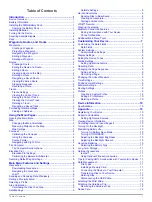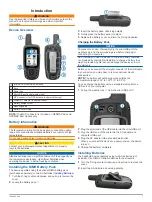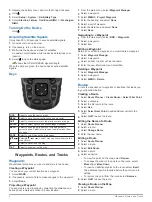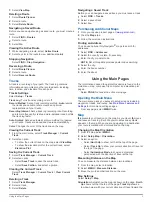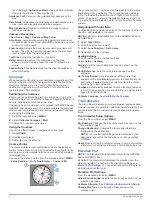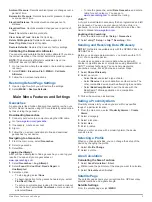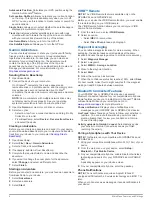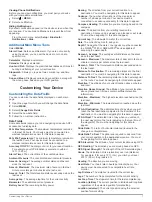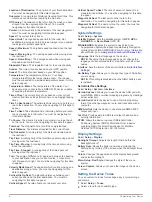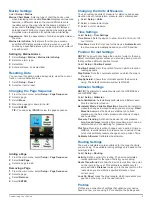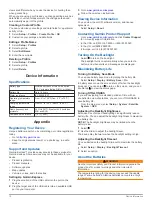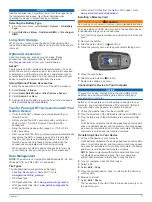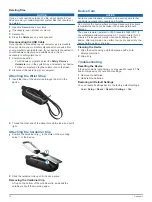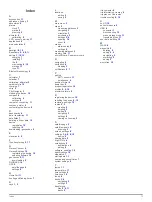
3
Select
View Map
.
Deleting a Route
1
Select
Route Planner
.
2
Select a route.
3
Select
Delete Route
.
Navigating a Saved Route
Before you can navigate using a saved route, you must create a
route.
1
Select
FIND
>
Routes
.
2
Select a route.
3
Select
Go
.
Viewing the Active Route
1
While navigating a route, select
Active Route
.
2
Select a point in the route to view additional details.
Stopping Navigation
Select
FIND
>
Stop Navigation
.
Reversing a Route
1
Select
Route Planner
.
2
Select a route.
3
Select
Reverse Route
.
Tracks
A track is a recording of your path. The track log contains
information about points along the recorded path, including
time, location, and elevation for each point.
Tracks Settings
Select
Setup
>
Tracks
.
Track Log
: Turns track recording on or off.
Record Method
: Sets a track recording method.
Auto
records
the tracks at a variable rate to create an optimum
representation of your tracks.
Recording Interval
: Sets a track log recording rate. Recording
points more frequently creates a more-detailed track, but fills
the track log faster.
Auto Archive
: Sets an automatic archive method to organize
your tracks. Tracks are saved and cleared automatically.
Color
: Changes the color of the track line on the map.
Viewing the Current Track
1
From the main menu, select
Track Manager
>
Current
Track
.
2
Select an option:
• To show the current track on the map, select
View Map
.
• To show the elevation plot for the current track, select
Elevation Plot
.
Saving the Current Track
1
Select
Track Manager
>
Current Track
.
2
Select an option:
• Select
Save Track
to save the entire track.
• Select
Save Portion
, and select a portion.
Clearing the Current Track
Select
Track Manager
>
Current Track
>
Clear Current
Track
.
Deleting a Track
1
Select
Track Manager
.
2
Select a track.
3
Select
Delete
.
Navigating a Saved Track
Before you can navigate a saved track, you must save a track.
1
Select
FIND
>
Tracks
.
2
Select a saved track.
3
Select
Go
.
Purchasing Additional Maps
1
Go to your device product page at (
).
2
Click the
Maps
tab.
3
Follow the on-screen instructions.
Finding an Address
You can use optional City Navigator® maps to search for
addresses.
1
Select
FIND
>
Addresses
.
2
Select the country or state, if necessary.
3
Enter the city or postal code.
NOTE:
Not all map data provides postal code searching.
4
Select the city.
5
Enter the house number.
6
Enter the street.
Using the Main Pages
The information needed to operate this device is found on the
main menu, map, compass, trip computer, and elevation plot
pages.
Select
PAGE
to choose the active main page.
Opening the Main Menu
The main menu gives you access to setup screens including
waypoints, tracks, and routes. See
for main menu settings pages.
From any page, select
MENU
twice.
Map
represents your location on the map. As you travel, moves
and leaves a track log (trail). Waypoint names and symbols
appear on the map. When you are navigating to a destination,
your route is marked with a colored line on the map.
Changing the Map Orientation
1
From the map, select
MENU
.
2
Select
Setup Map
>
Orientation
.
3
Select an option:
• Select
North Up
to show north at the top of the page.
• Select
Track Up
to show your current direction of travel at
the top of the page.
• Select
Automotive Mode
to show an automotive
perspective with the direction of travel at the top.
Measuring Distance on the Map
You can measure the distance between two locations.
1
From the map, select a location.
2
Select
MENU
>
Measure Distance
.
3
Move the pin to another location on the map.
Map Settings
Select
Setup
>
Map
.
Orientation
: Adjusts how the map is shown on the page.
North
Up
shows north at the top of the page.
Track Up
shows a
top-down view with your current direction of travel toward the
Using the Main Pages
3



